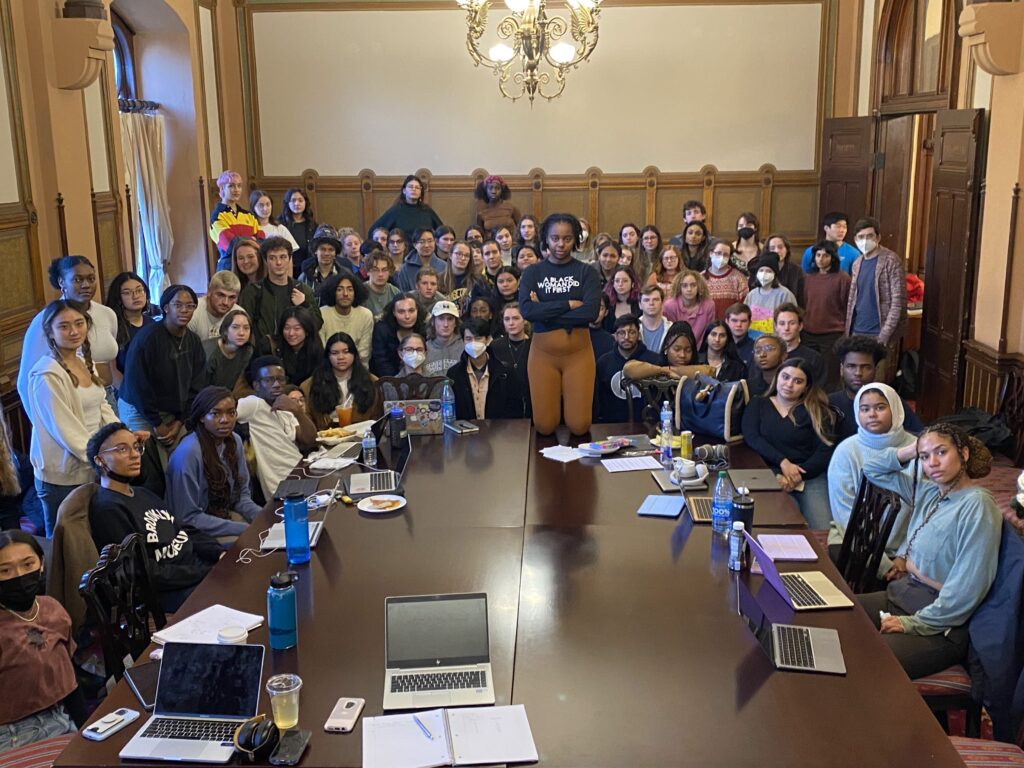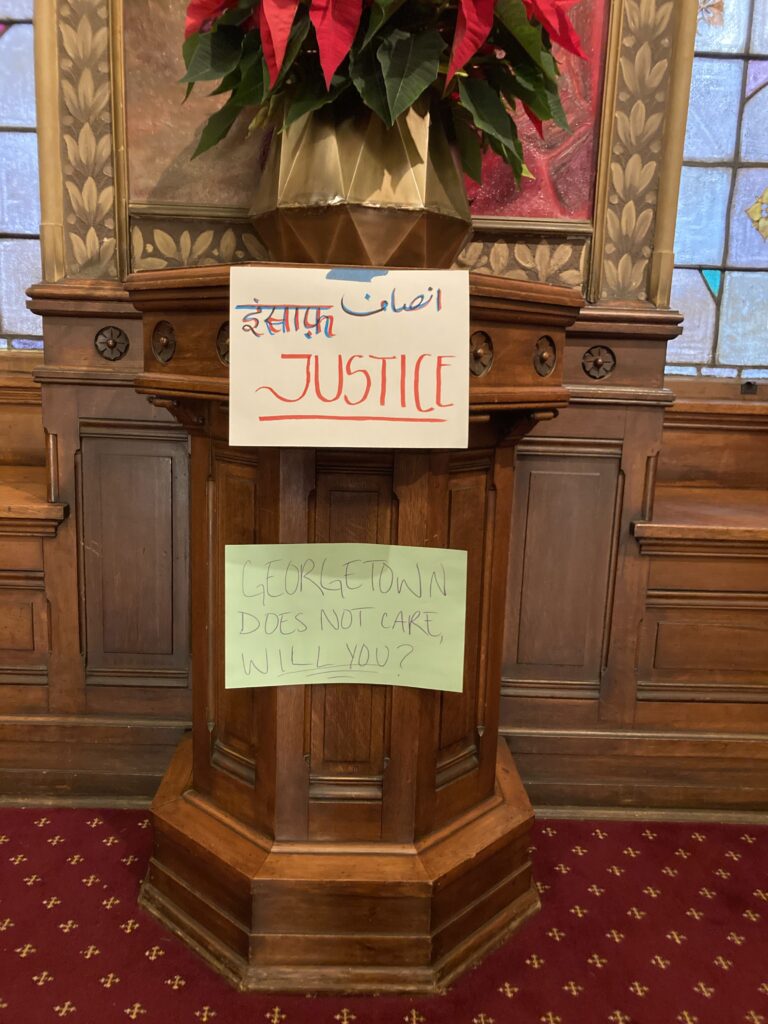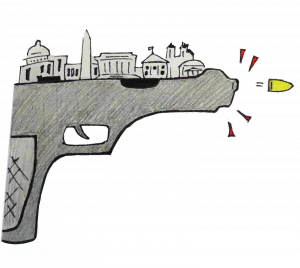Content warning: This article discusses anti-Black hate speech and systemic violence.
Students are occupying Healy Hall to demand accountability and justice for LaHannah Giles (COL ’23), the survivor of a racist hate crime on Georgetown Day this year. The sit-in began on Dec. 5 and is slated to continue until all of Giles’ demands—which include the expulsion of the perpetrator, acknowledgment of the harm Giles faced, improved accountability, and protections for Black students—are met.
Giles, who experienced a hate crime involving racial slurs and death threats shouted by a white student on April 29, organized the sit-in to protest the university’s failure to acknowledge that the hate crime occurred in the first place and the ensuing silencing of their story.
“Georgetown consistently fails its BIPOC students, especially its Black students. This university constantly promotes itself as a liberal institution, but it’s not as liberal as it thinks it is, especially if things like this are happening on this campus in 2022,” Giles said in an interview with the Voice. “Refusing to acknowledge that it’s happened contradicts their exact values to live out their mission.”
The sit-in is scheduled from 9 a.m. to 5 p.m. throughout the week, coinciding with the work hours of the President’s Office. There are hourly chants and programming at noon, which includes student speakers from various campus organizations, a chance for Giles to share their story, and dialogue between participating students.
At least 100 students participated on the first day of the sit-in, which Giles and other student organizers view as a powerful display of solidarity that they hope will continue.
“I’m just happy to see that word got out about the sit-in despite there being intentional efforts to stop it getting out through the intentional action of tearing down posters. I felt really supported today, being seen, believed, affirmed,” Giles said. “I truly felt like the community was in solidarity with me today.”

Photo by Sanchi Rohira LaHannah Giles (COL ’23) and students protested in the Philodemic Room, directly next to the President’s Office. Photo by Sanchi Rohira
The protest has drawn support from many organizations, including the Black Student Alliance, Black Leadership Forum (BLF), South Asian Society, GU Queer People of Color, African Society of Georgetown, MOSAIC, Caribbean Culture Circle (CCC), Center for Social Justice, the Corp, and GUSA. Several organizations have also donated food and water, marketing materials, and supplies.
“This is the definition of mutual aid and supporting one another,” Olivia Henry (COL ’24) said. Henry has attended meetings with Giles, and has been helping coordinate snacks, water, and even power strips to cultivate an environment that is conducive to studying as finals begin.

Photo by Franziska Wild Olivia Henry (COL ’24) handing out pizza provided by student organizers and supporters.Photo by Franziska Wild
Despite the student support they have received, Giles is frustrated by the need for a sit-in at all. To Giles, the university’s lack of follow-through, combined with repeated gaslighting, is a miscarriage of justice—an indication that the university does not take proper due diligence to address hate crimes against Black students. This has forced Giles, alongside other students, to take direct action to address the hate crime and the consequent harm it perpetuates.
On April 29, during Georgetown Day, a white male student leaned out of a New South window and began to yell racial slurs at Giles while they sat outside the Healey Family Student Center with a group of friends.
In addition to calling Giles the N-word, the student also said how much he hated N-words and how they “all needed to die.” A friend of Giles—who preferred not to be identified—yelled for the student to stop, but the student continued, only stopping when Giles pulled out their phone to record.
Immediately after, Giles called GUPD because they did not feel safe. Later that day, they filed both a police report and a bias report with the Office of Student Conduct (OSC). Giles did not receive a response to their report from the OSC until they followed up via email and a phone call the following week. They were informed on May 3 that GUPD was investigating the hate crime.
Giles described feeling disregarded by the administrators and GUPD as a direct result of the lack of communication. “I felt like I had been left in the dark. I felt ignored,” Giles said. “Some of the officers were extremely dismissive and turned me away.”
One day after the perpetrator committed the hate crime, Jay Gruber, the chief of police, and Jeanne Lord, the interim vice president for Student Affairs and Dean of Students, sent an email to New South residents asking for more information about the event, connecting students with Every Hoya Cares, and condemning the hate crime, although it was labeled as simply “racist remarks.”
“This is a deeply troubling report, and we strongly condemn any act of racism or hate in our community,” the email reads.
While awaiting an update about the status of their report, Giles uploaded a now-deleted LinkedIn post recounting the hate crime and the additional trauma they’ve experienced as a result of the university’s mismanagement of their case. The post went viral; Giles believes that it was only due to the widespread attention that she received a May 12 email response from Victor Lopez, the OSC assistant director.
In the email, Giles was told that the GUPD investigation had concluded the previous week and that the OSC had been forwarded the investigative report on May 6, although Giles had not been informed of these changes. The email also set up a meeting the next day with Lopez and Judy Johnson, the director of the OSC.
According to Giles, they were informed at the May 13 meeting that the Institutional Diversity, Equity & Affirmative Action (IDEAA) office would be taking over the investigation of their case. They were also told that GUPD had identified the perpetrator and the other students present based on video footage and GOCard records. They were then issued a no-contact order against the three students, the identified perpetrator and two of whom are still under investigation.
Although these steps were the most concrete taken by administrators to address the harm Giles had experienced at this point, the meeting was retraumatizing and unproductive, according to Giles. Giles was told what they experienced was not a hate crime. They also said they felt victim-blamed by Johnson.
Despite initially feeling relieved about the no-contact order, Giles said they have come to resent it. “I feel like this has been weaponized against me. It was a scare tactic on their end which I felt was meant to not only intimidate me but also silence me,” Giles said. “I can’t talk about the student, I can’t say his name, I can’t post anything about him on social media.”
Giles met next with Olabisi Okubadejo, the associate vice president of Equal Opportunity, Affirmative Action, and Compliance on May 20.
At this meeting, Okubadejo explained that GUPD had produced a report identifying the perpetrator based on the New South security footage, although his face was not visible. Despite the report naming the perpetrator, Giles was also told that GUPD had since lost the video footage of the racist hate crime, which was later confirmed in writing in a Sept. 9 email from Okubadejo.
Since May, Giles has been told three different narratives about the loss of GUPD footage. First, they were told it was not maintained by Okubadejo. They were later told in a Dec. 1 meeting with Rosemary Kilkenny, the vice president for Institutional Diversity and Equity, that the GUPD server ran out of storage space for the footage. Finally, on the first day of the sit-in during a meeting with Kilkenny, Joe Ferrara, and Jeanne Lord, Giles and other students present were told that the footage had been lost due to an unexpected server failure.
This final explanation was further stated in an email sent to the Voice by a university spokesperson on Dec 6, who noted that new servers have been installed to prevent the problem in the future.
On May 27, Okubadejo spoke with two witnesses of the racist hate crime who were able to corroborate Giles’ story. Shortly after, Okubadejo reached out to four students, including the suspected perpetrator, and gave them 20 days to respond, as per university policy relating to bias incidents. She later told Giles that the students denied all involvement.
At this point, Okubadejo told Giles that the university would be unable to charge the students with any sort of disciplinary action. Although Giles requested the investigation remain open, Okubadejo followed up with a Sept. 9 email where she confirmed that no punitive action could be taken due to the hate crime’s failure to meet the university’s “clear and convincing” standard for allegations that occurred on campus—which requires a high probability that the incident occurred.
Due to the trauma of the incident and the impact of the university’s response on their mental health, Giles began looking elsewhere for justice. She reached out to other students and began organizing around the issue. She shared her story on Instagram and began to plan the December sit-in.
Giles sees this kind of direct action as the only method to force an inflexible institution into action. Their list of demands includes that the student who committed the racist hate crime be expelled, and also that testimonial evidence be included in future investigations.
A university spokesperson wrote that testimonial evidence is already included as part of the investigation process, although its current weight in considerations is unclear; Giles was told in a Sept. 9 email that there was no concrete evidence in her case, despite multiple witnesses confirming Giles’ account.
“For me, justice looks like, you know, expelling the student who I’ve identified as the perpetrator regardless of whether or not the video footage was lost,” Giles said. “I don’t think it should be an all-or-nothing thing. The video footage shouldn’t be the reason they’re holding back from expelling the student.”
They demand that GUPD release a statement that explains why they failed to document the hate crime and how the video footage from New South was lost.
“Justice for me looks like GUPD acknowledging the harm they’ve caused me in a public manner; to me, but also in a public manner as well,” Giles said.
According to a university spokesperson, GUPD’s exclusion of the incident from its Daily Crime Log was due to it, at the time, being classified as a bias incident rather than a hate crime. The incident has since been published in the Daily Crime Log after being reclassified as a hate crime.
Giles is also seeking an internal review of how the IDEAA, OSC, and GUPD handled her case, as well as an external review of how they handle bias and hate crimes in general—with particular scrutiny of Johnson’s tenure as director of OSC.
Giles also wants Georgetown to acknowledge how it has harmed her and to do so publicly.
“Justice for me looks like Georgetown acknowledging all the harm they’ve caused me the past six months: having me do the job of people who were hired to serve and protect me, and they failed immensely at their job,” Giles said. “Justice for me looks like not only them acknowledging all the harm they’ve caused me, but publicly acknowledging it, so the entire community can hold them accountable.”
Finally, Giles wants the university to commit to longer-term actions to protect Black students and other students of color. These include the creation of a public communal space offered to the Black Student Alliance that is not the Black House, increasing funding for the Student of Color Alliance, extending the Black Survivors’ Coalition (BSC) Treatment Initiative for the next five years, and creating a separate office/division responsible for overseeing all bias incidents on campus.
Until these demands are met, Giles and other students plan to continue the sit-in. Her story is not just a singular incident; rather, it belongs to a larger pattern of violence against Black students.

Photo by Franziska Wild Students posted signs in support of Giles around Healy Hall.Photo by Franziska Wild
Saleema Ibrahim (SFS ’23), a consistent participant at the sit-in, agrees and notes that because the perpetrator has not been expelled, they are a continued threat to Black students and students of color on campus.
“Georgetown has a legacy of not caring about or meeting the demands of students of color, particularly Black students. Six months ago it was LaHannah, tomorrow it could be any of us,” Ibrahim said. “There was a reason that he felt comfortable to shout those slurs from New South, a freshman dorm, and think that he wouldn’t receive any consequences.”
Annaelle Lafontant (SFS ’23), who is heavily involved with BLF and is the president of the CCC, sees Georgetown’s response to Giles as part of a larger pattern of Georgetown disregarding its Black students.
“Georgetown historically doesn’t care about Black students, it doesn’t care about its legacy of racism, it doesn’t care about its present-day racism,” Lafontant said. “I don’t want people to think that this is an isolated incident. I want them to understand what it’s like to be a Black student on this campus.”
Ibrahim, who attended the BSC sit-in when she was a first year, emphasized the parallels between this sit-in and the one three years ago.
“It’s a difficult, weird full circle moment. Well, we’re back here again because the university has failed to do their job of protecting students. We’re kind of back at the same crossroads of GUPD just not doing their job, claiming to lose footage,” Ibrahim said.
Despite the heavy physical, emotional, and spiritual toll that this sit-in puts on the students, they are intentional about making the space one that promotes community, care, and solidarity.
“It was something that I comfortably say I am grateful to have been able to contribute to and be a part of, because it truly did feel like movement building. It felt like conversations turning into action,” Henry said in reference to the first day of sit-in.
Sanchi Rohira (COL ’24), who is helping to coordinate social media and material supplies for the sit-in as well as joining meetings with administrators, sees this as a way to build collective power and push the university to address its racism.
“I really want this to serve as sort of a north star for people in this community to feel their power,” Rohira said. “Even the threat of the sit-in prompted administration officials to set up meetings with LaHannah, to take demands more seriously, to come to the negotiating table in either good faith or an extremely well-founded fear for their reputation.”
Lafontant agrees, and also sees the sit-in as Black students and allies taking action to protect themselves in the face of a university that won’t. “That’s why I’m here—here to support LaHannah, here to show Georgetown that Black students matter, that we will defend ourselves,” Lafontant said.
Rohira also sees the sit-in as a space for dialogue to consider intersectionality and solidarity amongst communities.
“I think while we’re all here, we should take this as an opportunity for the non-Black POC and for the white students here, we need to take this as an opportunity to learn about the ways in which anti-Black racism is perpetuated in more insidious ways on this campus,” said Rohira.
As the sit-in continues, Giles and fellow organizers are planning a protest, teach-in, and day of action on Dec. 7. Although the sit-in will begin at 9 a.m., the protest will begin at noon from the front gates and march from there to the GUPD and IDEAA offices.
“This is the most important moment in terms of numbers and visuals. What we want is to see a huge swarm of students who are moving towards Healy Hall, demanding justice with flyers.” Henry said. “And we really want to see that physical show of support, that’s really important.”
Editor’s note: This article has been updated to correct a minor quote attribution error.





The more I hear about this story the more I become distant from supporting it. Beginning take, hearing that LaHannah was shouted at with a racial slur and other disgusting language, none of this should be socially acceptable in public or on a campus and I guarantee there’s a school policy against student conduct for this. But unfortunately for LaHannah there is no evidence of this interaction beyond her experience and you cannot rely on heresay for stuff like this, especially when demanding a student be expelled. She even admitted that the video did not catch her perpetrator in action. It has also been incredible hearing this entire thing turn into a “hate crime” which from my understanding specifically excludes hate speech (unless compounded with another criminal act). Additionally, some of these demands like creating a segregated space on campus and extending Georgetown bureaucracy (or we won’t stop protesting) is such a far reach as to be impractical.
I support LaHannah’s right not to be harassed on her campus, I also think that unfortunately sometimes we can’t get justice on things because we don’t have enough evidence against perpetrators, as in this instance. And the provocative, misnomer, language and ridiculous demands have nothing to do with this incident and seem much more like distortion of reality and “seizing the opportunity.”
“Hoya 22” let me respond to you here since I although I am not obligated to. Comments like yours are the exact reason why Black women are afraid to come forward about their stories let alone why Black women are never believed. My pronouns are they/she. Please respect them accordingly.
In this comment, you have mentioned that you cannot rely on anything I have said because I don’t have proof. I have five witnesses who saw this hate crime unfold to be exact. I have no reason to make any of the things up that happened to me or that were said. A student called me the n-word. He said all n-words needed to die. He also targeted me specifically, which included threats and intimidation. I have even moved off campus as a result of this. Under the DC Clery Act, this is a hate crime. You are wrong and in no position to question the validity of my story or the classification of a hate crime. Learn the law.
In this comment you have mentioned that I admitted to not catching the perpetrator on camera. I have never said anything like that. I do have a video of it and it catches his face, which has been used as evidence. Why are you spreading lies about me? This is so weird of you. I have proof.
In this comment you mention that the demands are unrelated. You said that I have used this as a seize the moment opportunity. The demands are completely related, especially the demand about asking for an affinity space. I sat in the sit-ins and explained them to everyone at some point. I don’t need to explain them again to you. The people that get it, get it. I am not advocating for segregation. I am advocating for an affinity space for students who exist on a largely white campus. These can be best understood as Predominantly White Institutions (PWI) incase you didn’t know.
If you want to further discuss this outside of a public setting without the masking of your identity, feel free to message me on Instagram. Whether or not I have your support doesn’t matter to me when I have the support of the broader community.